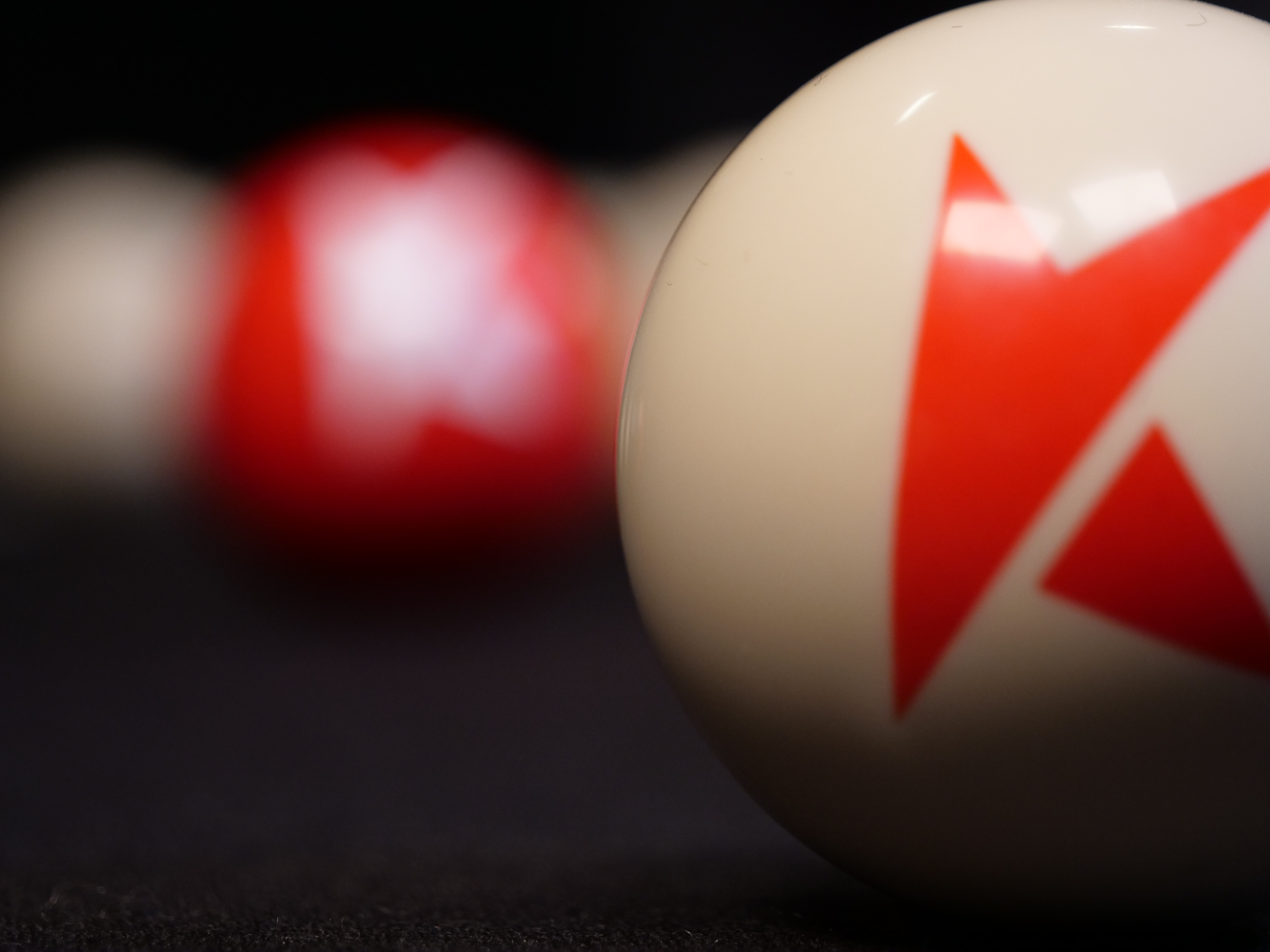Method Of Play
A list of all the rules concerning the Method Of Play in Kojammi-Pool
Overview
A Kojammi-Pool Match begins with the Player’s Toss. The winner of the Player’s Toss will have the choice as to whether to play first i.e Set The Score or have their Opponent play first i.e Chase The Score. Frame Points are awarded to the Player who has the highest Score at the end of a Frame. Reach the required number of Frame Points within Normal Time secure a Victory.

Order Of Play
- A Kojammi-Pool Match begins with the Player’s Toss.
- The winner of the Player’s Toss will have the choice as to whether to Set The Score or Chase The Score.
- From Frame to Frame, Players alternate who Sets The Score.
- Frame Points are only awarded to the Player with the highest Score in a Frame once the Opposition has had their Right Of Reply. This Rule applies with the exception of an Active Player securing a Kojammi Pot.
- The Player who secures the required number of Frame Points within Normal Time secures a Victory.
Table Specifications
Kojammi-Pool is played on a regulation standard 8ft pool table (Playing Area = 44″ x 88″). The Live Line must be placed one quarter of the length of the table or 22″ away from the Playing Zone Cushion. The Kojammi Spot must be placed 22″ from the Back Cushion and equidistant from the Side Cushions. The Black Spot must be placed 11″ from the Back Cushion and equidistant to the Side Cushions. Competitions must be conducted on a regulation Kojammi-Pool Table as defined by the WKPA in the Definitions section.


Frame Scoring
- Where Players have registered a Score but have failed to legally Pot the Black Ball or Kojammi Ball, the Player who has Potted the most White Balls is awarded one Frame Point.
- Where Player/Players have managed to Activate the Black Ball and subsequently Pot it, the Player who Potted the Black Ball is awarded two Frame Points pending their Opponent’s usual Right Of Reply. The Player’s Score at this point is said to be a Black Ball Pot.
- Where an Active Player manages to legally Pot the Kojammi Ball in a Kojammi Pocket the Active Player is awarded two Frame Points without the Opponent’s usual Right Of Reply. The Player’s Score at this point is said to be a Kojammi Pot.
- In the instance that Players both register the same Score within a Frame, the Frame Points will be awarded to whichever Player has the shorter Round Time.
- The hierarchy of Scores in a Frame will be as follows: the number of White Balls Potted, overridden by a Black Ball Pot, overridden by a Kojammi Pot.
Draws and Stalemates
- A Stalemate will be declared by the Umpire in a Frame only if both Players have the same Score and Round Time at the end of the Frame.
- If a Stalemate is declared in a Frame, no Frame Points are awarded for that Frame and an additional Frame is added to the total number of Frames in a Match.
- If a Stalemate is declared by the Umpire in a Frame, the Player who Set The Score in the Frame in question will Set The Score in the following Frame.
- A Draw will occur in a Match if both Players enter Over Time or if the Player in Over Time manages to get to the required number of Frame Points to what would have constituted a Victory in Normal Time before their Opponent.

Ethos Of The Set-Up
The Set-Up offers the opportunity for Players to express individuality. Opposing Players assemble the Set-Up for the Active Player to choose their Starting Balls from.
Rules Concerning The Set-Up
- Opposing Players are permitted to assemble the White Balls in any manner or place Outfield that they choose when Setting-Up in so long as said White Balls are not placed in the part of the Table between the Middle Pockets and the Live Line.
- The Black Ball must be placed on the Black Spot as part of a Set-Up.
- The Kojammi Ball must be placed on the Kojammi Spot as part of a Set-Up.
- Active Players are entitled to select any three White Balls from the Opponent’s Set-Up as their Starting Balls.
- Active Players may not Touch more than three White Balls in an Opponent’s Set-Up when selecting their Starting Balls.
- Active Players will be deemed to have selected a White Ball from an Opponent’s Set-Up upon the incidence of the Active Player Touching said White Ball/White Balls.
Player’s Responsibilities
Kojammi-Pool is a sport rooted in the principles of sportsmanship and fair play. Player’s are expected to abide by all the rules set out and endorsed by the WKPA.

- If a Player Concedes a Match at any point they lose the Match. This applies to Players in both Normal Time and Over Time.
- If a Player refuses to continue with a Match said Player will be deemed to have Conceded.
- Any decision made by the WKPA in relation to a result which has been under review is final.
Rules Concerning The Players Responsibilities
- It is the Players responsibility to make themselves aware of the Rules of Kojammi-Pool.
- It is the Players responsibility to make themselves aware of any schedules relating to any competitive encounters.
- Players must at all times abide by the Rules of Kojammi-Pool as set out by the WKPA.
- When no Umpire is present, Players are required to operate their own Clocks and to do so in an honest manner.
- Players must retain a level of sportsmanship which is consistent with rules of common decency. Players who fail to do so will, at the discretion of the Umpire, or upon review, be subject to the Disciplinary Procedures as set out by the WKPA.
- When no Umpire is present, Players must report results honestly and truthfully of competitive Matches that they have been a part of as part of a tournament or competition to the WKPA. When an Umpire is present, they will assume the responsibility of honestly and truthfully relaying any results of a Match to the WKPA.
- If a Player feels that an Umpire’s decision is incorrect, they may ask the Umpire to reconsider the decision and grant them a Time Out in which to make their case. The Umpire’s final decision is final within a Match.
The Opposing Player’s Responsibilities
- Opposing Players are responsible for ensuring that all the Balls are on the Table prior to the start of an Active Player’s Round (see Rules Regarding Ball Omissions By The Opposing Player).
- The Opposing Player is responsible for positioning Penalty Balls Outfield following a Standard Foul by an Active Player.
- Opposing Players are responsible for Re-Spotting the Black Ball following a Black Ball Foul.
- The Opposing Player is responsible for creating the Set-Up for the Active Player.
- The Opposing Player is responsible for ensuring that they place any Penalty Balls Outfield in a timely manner. (See Unsportsmanlike Conduct).


Rules Concerning Ball Omissions From A Frame
- Opposing Players must ensure that all 14 White Balls, the Black Ball and the Kojammi Ball are on the Table prior to commencing their Round and/or the Frame. Any Balls which the Opposing Player fails to put on the Table as part of their Set-Up count as Pots for the Active Player should the Active Player commence with their first Roll.
- Should either Player notice that a Ball is missing from the Table prior to a Frame commencing they are expected to report the omission to their Opponent.
- Should neither Player notice the omission of a Ball from a Set-Up at the start of a Round and the omission be noticed during the course of a Frame or after the fact upon review, then the omission stands and the Score of the Player altered accordingly.
- Should an altered Score lead to an ulterior result in a Match, the corrected Score stands.
- Should an altered result lead to an unresolved Match, the Player who Potted the most White Balls within the Match will be declared the winner of the Match.
